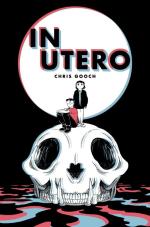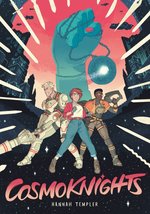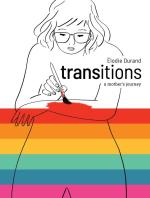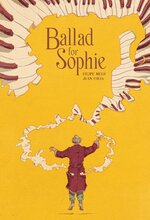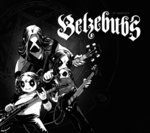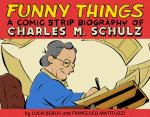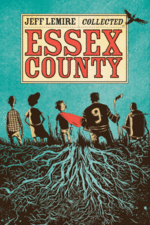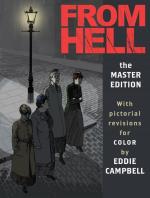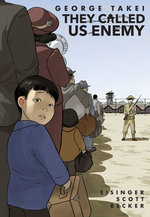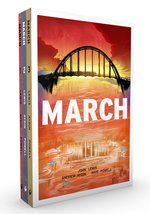picturebook pedagogy #3.
May 3, 2010
Here, ladies and gentlemen, for your reading entertainment, is the third in a series of guest columns by Trevor Dodge. Take it away, Trev.
••••••••••••••••••••••
Picturebook Pedagogy #3: The Medium is The Message
 I'm fully realizing this term how impossibly ambitious most college-level comics courses are, especially ones that mostly function as gateways to the picturebook world. Taking introductory courses in comics isn’t at all like taking intro courses in such absurdly/broadly/badly-drawn literary genres like fiction or the essay. Because at least as far as these particular genres are concerned, they have a mommy, and mommy’s name is Prose. Prose, of course, is the low-tech artform of clunking down letters next to other letters so as to create things called words, (which are of course clunked down to other words), and when you get enough words together, you call that a sentence (which of course are clunked down next to other sentences), and when you get enough sentences together, you call that a paragraph (which aren’t exactly clunked down next to one another so much as stacked on top of each other like a tower of Jenga blocks).
I'm fully realizing this term how impossibly ambitious most college-level comics courses are, especially ones that mostly function as gateways to the picturebook world. Taking introductory courses in comics isn’t at all like taking intro courses in such absurdly/broadly/badly-drawn literary genres like fiction or the essay. Because at least as far as these particular genres are concerned, they have a mommy, and mommy’s name is Prose. Prose, of course, is the low-tech artform of clunking down letters next to other letters so as to create things called words, (which are of course clunked down to other words), and when you get enough words together, you call that a sentence (which of course are clunked down next to other sentences), and when you get enough sentences together, you call that a paragraph (which aren’t exactly clunked down next to one another so much as stacked on top of each other like a tower of Jenga blocks).
I belabor this digression with you here only to underscore how ingrained these ideas are for us because we’ve been taught these systems of ciphers and architecture from, well, before we were born (if your mommy never talked to you in utero, shame on your mommy. Bad mommy!), to the point where these systems feel completely natural to us.
 But you know something? They’re not. Words are comprised of letters. And letters are pictures for sounds. Remember Hooked on Phonics? And but also, why does your alphabet (ahem, The Romans’ alphabet, sorry) look and sound different from someone else’s alphabet (say, The Persians’)? Because it was designed that way, silly. Didn’t mommy never teach you nothin?
But you know something? They’re not. Words are comprised of letters. And letters are pictures for sounds. Remember Hooked on Phonics? And but also, why does your alphabet (ahem, The Romans’ alphabet, sorry) look and sound different from someone else’s alphabet (say, The Persians’)? Because it was designed that way, silly. Didn’t mommy never teach you nothin?
I brought this genre issue up with Mister Warnock, who immediately took issue with the comparison and fired off this response:
Really? Fiction and essays are genres? Really? I bristle when comics are mentioned as a genre, because anything under the sun can be the subject matter in a comic. And I would think the same about an essay. Fiction? Not sure. But even within that rubric the potential seems rather broad.
 I, too, bristle at the description of comics as a “genre,” and I wonder if we too often confuse that particular term with the term “medium.” Because with comics, this simple transposition could too easily privilege the subject matter of comics over its form (or its genre, which may very well be connected to issues/ideas of form). An example of this problem might be easier to see in the assumptions of lay readers of poetry. A lot of students in my own survey courses assume a poem largely to be a derivation of a genre we can easily identify as the sonnet: it has an iron-clad rhyme scheme, runs 14 lines, and usually has the same sensibility of an emo kid crying. To view all of poetry (which is a medium) through the narrow lens of the sonnet (which is a genre) is largely to not see the medium at all.
I, too, bristle at the description of comics as a “genre,” and I wonder if we too often confuse that particular term with the term “medium.” Because with comics, this simple transposition could too easily privilege the subject matter of comics over its form (or its genre, which may very well be connected to issues/ideas of form). An example of this problem might be easier to see in the assumptions of lay readers of poetry. A lot of students in my own survey courses assume a poem largely to be a derivation of a genre we can easily identify as the sonnet: it has an iron-clad rhyme scheme, runs 14 lines, and usually has the same sensibility of an emo kid crying. To view all of poetry (which is a medium) through the narrow lens of the sonnet (which is a genre) is largely to not see the medium at all.
To Brett’s point, though, the same could be said about the medium of prose, which takes specific form in genres/traditions we might label as the short story, the novel, and/or the essay. Because where The Bartender and I might quibble over what is/isn’t a genre, there’s no doubt we are in lockstep in believing very fervently that comics is a medium, and thus is capable of doing a wide range of communicative tasks.
So to the pedagogical problem at hand: with only three months to teach a course introducing an entire medium, what are the essential works in said medium? I wrestle with this question at least three times every academic year, when I draft my reading assignment sequences and submit orders to the campus bookstore. And at least three times every year, I end up feeling like I’ve cut corners in all sorts of ways (time, mostly, but also factoring in price, length and relevance) to boil down an entire medium to an arbitrary list that always leads to the “But What About ____?” nagging that haunts me from week to week.
This winter/spring, I’ve been teaching two courses on comics at two very different colleges. One is a private fine arts school, the other a public community college. The former uses the traditional 16-week semester schedule, the latter an 11-week quarter. Both courses approach comics for their narrative/literary qualities, and largely serve as introductions to the medium. As I mentioned in my inaugural post here, I’m finding that as I teach these courses more and more, a wider and wider range of students are coming out every term to take them. This is both exhilarating and daunting, and I’ve had to adjust my reading assignments accordingly.
Here, then, is a combined list of the texts I’m currently teaching between the two classes. I’ve also done my best to provide a brief rationale for each text because, well, I like to think my mommy taught me plenty. (The Bartender, too, as far as that’s concerned!):
Scott McCloud: Understanding Comics
(What, you didn’t read my last post? For shame!)
 Robert Kirkman and Tony Moore: The Walking Dead Vol.1: Days Gone Bye
Robert Kirkman and Tony Moore: The Walking Dead Vol.1: Days Gone Bye
Zombie comics always hit a nice gooey soft spot with my students for some reason, and Kirkman’s series is arguably the best thing going in monthly horror books. I usually work in some cultural studies work on the Comics Code Authority, which always brews an interesting conversation about the lines between making art and consuming product.
Chris Ware (ed.): McSweeney’s #13
No single book convinced me I needed to teach a course on comics more than this one. Ware gives us not only a beautiful art object, but an impressive history lesson in the Western comics tradition. The range of contemporary work in this single collection is unmatched.
David Mazzucchelli: Asterios Polyp
Believe the hype. AP was worth the wait. It’s quite literally something theory heads, philosophers, graphic designers, narratologists, art critics and a whole gravytrain of academics have been waiting for years to talk about. I recently hosted a reading discussion about this book at the Stumptown Comics Fest, and I was amazed by how quickly a group of strangers could fall so easily and deeply into a sustained conversation about representation, structure, and human relationships.
 Matt Kindt: Super Spy
Matt Kindt: Super Spy
Gorgeous design both in its artwork and narrative interlacing have always entranced me. I was fortunate enough to get Kindt to visit one of my classes a few weeks ago, and he was completely comfortable sharing his process, aesthetics and agenda for comics with us. Also, students who read this book the first time I taught it (three years ago) are still talking about it.
Frank Miller, Klaus Janson & Lynn Varley: Batman: The Dark Knight Returns
I taught an entire literary theory course at Clackamas CC last year on Watchmen, and I burned myself out not just a little on the experience, this despite having Dave Gibbons beam into the classroom via videolink and charm the collective/proverbial pants off us for a full hour from half-way around the world. Because Watchmen is frequently paired with TDKR both aesthetically and rhetorically, I thought it was simply time to swap them out. Yes, it’s cliche and pat to describe Miller’s characterization of Bruce Wayne as having almost timeless relevance for whatever political strife we might be experiencing, but that doesn’t make it any the less true.
Will Eisner: Last Day in Vietnam
Until this year, I had never taught a full Will Eisner book. Now, after doing so, I will never repeat the mistake. In Western culture, Eisner is to comics what Shakespeare is to drama; it’s getting harder and harder for me to see them sharing variants of their given name (“William”) as mere coincidence. This isn’t about genius either, necessarily. Both Mister Eisner and Mister Shakespeare fundamentally retooled their respective artforms and updated them for application in their contemporary culture. One of those things people like me like to talk about with Shakespeare is how he blurs high and low art forms in drama, appropriating from and rebroadcasting to the popular culture. Eisner does exactly the same thing in comics. Neither men were careless about what they were doing, either.
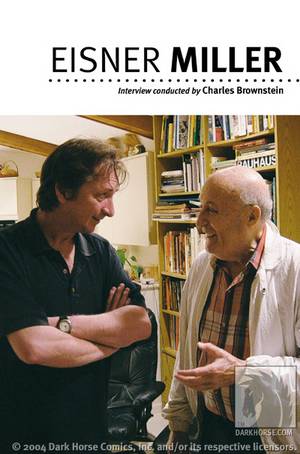 Will Eisner and Frank Miller: Eisner/Miller
Will Eisner and Frank Miller: Eisner/Miller
I’ve been excerpting from this book for years, but deliberately bringing TDKR and LDiV into the reading assignments set up the perfect theory + practice framework for me to use the full monty. Plus it gave me an excuse to have Diana Schutz come in to talk about how editing comics is an artform entirely unto itself.
Diana Schutz (ed.): Sexy Chix and Noir
I just mentioned Schutz’s editorial prowess, and this term I’m teaching two of her anthologies from Dark Horse Books. Academia tends to give a lot of attention to long-form work in comics, but not nearly enough to the medium’s ability to tell effective stories with a shorter burn. Just as we differentiate between the novel and the short story in prose, we need to be better about differentiating between the “graphic novel” and the “graphic short story” in comics. And probably the first place we need to start is being more precise and responsible with that well-meaning but nonetheless terrible catch-all phrase “graphic novel,” which is far too often used euphemistically by people who are actually talking about the medium of comics but are somehow incapable of using the term “comics.” But I digress, per usual. Short-form comics have a wide range as well; we can talk about cartoons, webcomics and newspaper strips as kindred spirits to prose poems or micro fictions, but there is definitely a lot of room between these ultra-compressed forms and much longer pieces we call graphic novels/memoirs. The work of Yoshihiro Tatsumi comes immediately to mind, whose work always reminds me of the best stuff by clear masters of the short story in prose, writers like Charlotte Perkins Gilman, Raymond Carver, Eudora Welty and Jorge Luis Borges, as well as contemporary genius-craftspeople like Gary Lutz, Monica Drake, Matt Bell and Lidia Yuknavitch.
Alison Bechdel: Fun Home
In past years I've used Marjane Satrapi’s Persepolis in my intro classes, but after teaching Bechdel’s book in an expressions/articulations of femininity in comics course last year, I decided to swap them out. Autobiographical stories are arguably the medium’s most poignant and powerful expressions, and this is something the New York publishing houses have known for quite some time. There is literally way too much to choose from when it comes to amazing autobio comics, so any single choice is doomed to come across as myopically arbitrary. But as much good stuff is out there, Bechdel’s Fun Home stands above most in terms of its emotional resonance, intellectual playfulness, and meticulous composition. Craig Thompson's Blankets is a close second for me in these regards by the way, and you have to know that I really hate even the possibility of implying Thompson is in ANY way secondary. This is partly why this upcoming fall I’ll teaching an entire course in autobio comics, and yet another in the winter, where I’ll have the opportunity to teach both Bechdel and Thompson, plus a whole bunch of others—-Harvey Pekar, Jeffrey Brown, James Kolchaka, Phoebe Gloeckner and Aline Kominksy, just to name a few.
 Lynda Barry: One! Hundred! Demons!
Lynda Barry: One! Hundred! Demons!
During my first year as full-time faculty at the community college, Lynda Barry graced our department by both giving a lecture and writing workshop that still has the campus buzzing nearly seven years later. The frenetic energy and honesty in her work—no matter if it’s her comics, collagework, or even her prose—-always catches at least one student in the exact place and time that (s)he needs to be caught, and I’d be lying to you if I tried to downplay how much of teaching boils down to turning on just one person to an artist that utterly blows their mind and forces them to see the world from a different point of view. For many students, Barry has been that artist. The planet is truly a better place because she is on it.
 Tezuka Osamu: Buddha Vol. 1: Kapilavastu
Tezuka Osamu: Buddha Vol. 1: Kapilavastu
I am largely ignorant when it comes to comics in other cultures, especially Japanese comics. Last year I decided to take a play out of one of my literature prof’s books and to assign one text/artist in the class that I knew was of significance but had not read yet. In essence, to force myself to engage the material much the same way my students are asked to do. Osamu’s mashing up the spiritual with the carnal and commodity fetishization is an astonishing artistic move; where most efforts like this come off as sophomoric hackery, Osamu’s work manages to find a truly transcendental mindspace that only the comics medium can deliver.
So there’s the list, and there are huge, obvious omissions to be sure. What are they? If you were designing your own “Comics 101” course, what would be mandatory reading for your students? Any particular works in this medium you'd use to draw their attention and make your arguments?
